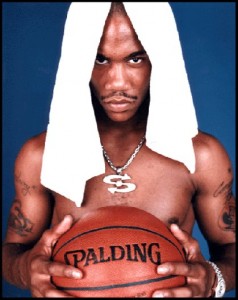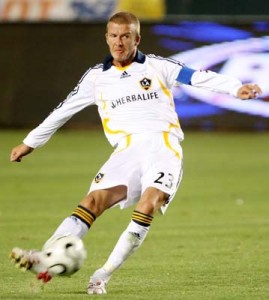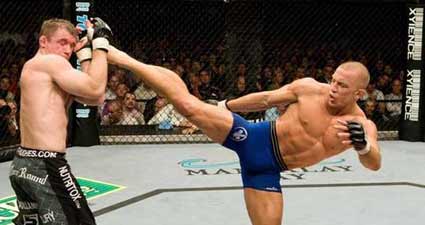At long last, MMA has arrived in Ontario
 It took a couple of reversals, but Premier Dalton McGuinty has finally made the right decision and ruled that professional mixed martial arts fights can be held in Ontario, paving the way for a lucrative Ultimate Fighting Championship card in Toronto sometime in 2011.
It took a couple of reversals, but Premier Dalton McGuinty has finally made the right decision and ruled that professional mixed martial arts fights can be held in Ontario, paving the way for a lucrative Ultimate Fighting Championship card in Toronto sometime in 2011.
I’ve long supported this move, including a lengthy blog post in February after McGuinty said that the ban on MMA was not going to be lifted.
But now that the Premier has changed his mind, it’s worth repeating some of the arguments in favour of the emerging sport.
As most proponents of MMA have argued, it’s actually the safest of the combat sports because the referees have more discretion to stop the match and as a result are more proactive in ending lopsided bouts.
As a result, unlike boxing’s standing counts, once a fighter has sustained a serious blow to the head, the match is over. This prevents concussions and long-term brain damage.
Old school sports commentators often complain about the blood and savagery of the sport, while championing traditional combat sports like boxing, wrestling, judo and tae kwon do.
This is a weak argument on their part. After all, MMA incorporates strategy and training from all of those disciplines. There’s no case to be made against the submission moves of the UFC when wrestling, one of the world’s first Olympic sports, relies on many of the same moves.
Further, prizefights were already being held on some Native reserves. Legalization province-wide would mean that better, more expansive safety regulations would be created, insuring that mixed martial artists would be guaranteed higher safety standards.
There is also the economic benefit. Toronto is a sporting city and the home base for almost all of Canada’s major media outlets. A major MMA event here would expose the sport to even more people and create a buzz around the industry.
In their press releases the Ontario government has estimated that it’ll generate approximately $6 million for Toronto-area businesses.
I’m no economist and I don’t know how these estimates work or how accurate they are, but obvious that like any big event - concert, conference, festival, whatever – a UFC event would provide a boost to Ontario’s economy.
Without getting too political, I will say that it’s nice to see that Premier Dalton McGuinty changed his mind and is, at long last, welcoming mixed martial arts and promoters like the UFC to Ontario. It's one of those rare win-win situations: it will be good for the sport and for the province.
The Arenas Rule

With an unseemly Arenas Rule Point rating of 8, no NBA executive should consider Stephon Marbury as an addition to their team ever again.
As I was writing Tuesday’s piece on why players leave Toronto’s sports teams, I began to toy with the idea of athletes who have moved from team to team, and came to the conclusion that there’s a point where any general manager should see a player’s team history as a red flag.
I call this policy the Arenas Rule, after recently disgraced Washington Wizards star Gilbert Arenas who, thanks to his criminal gun charges, will likely be joining his third National Basketball Association team sometime this summer.
Here’s the technical language:
Arenas Rule (also known as the Shaq Threshold) – Any athlete who has played for three or more franchises in their professional career is not worth signing as a free agent or trading for under any circumstances.
The Rule only applies to athletes who’ve been previously selected to their league’s all-star teams and/or won an individual award (MVP, Rookie of the Year, Triple Crown, Defensive Player of the Year, etc.)
The logic is simple. Although this former all-star might pay dividends when playing, they’re not worth the trouble off the court/ice/playing surface of your choice. It relies on the assumption that, like a first date who has to count off their exes on their fingers, they’re not worth the time or effort.
Presumably, this veteran player has a nagging injury, is locker room poison, has an unwieldly contract, has lost a step due to age, is crazy or a combination of all of the above. Somehow, someway, they are damaged goods.
Each team they play for adds an extra Arenas Rule Point on to their evaluation, increasing the risk of the move exploding in the GM’s face. Any athlete that has an ARP of 3 or higher is bad news and is going to severely damage the team’s chemistry, salary or reputation.
There are some stipulations that can both add or subtract from an athlete’s ARP score:
Nash Caveat (also Seller’s Remorse) (ARP rating = 0) – Referring to NBA All-Star Steve Nash who was traded from the Phoenix Suns to the Dallas Mavericks only to re-sign with the Suns as a free agent, the Caveat stipulates that a player shall not have a second tenure with a team count against their ARP score.
By all accounts, Nash is a not just a great player, but a great person. So likeable that even Canadians comment on how nice he is, the Suns welcomed him back with open arms, having regretted ever letting him get away. A player shouldn’t be punished for a GM’s hasty decision making.
Millbury Allowance (ARP rating = -1) – Used judiciously, the Millbury Allowance forgives players who were traded in incredibly lopsided deals.
An acknowledgment that not all GMs are created equal, the Allowance refers to former New York Islanders GM Mike Millbury who regularly traded away his best players for terrible returns. For example, Roberto Luongo is one of the best goalies active in the NHL today, but has an ARP rating of 3. He’s been moved from the Islanders to the Florida Panthers and then to the Vancouver Canucks. It’s not his fault that Millbury didn’t know what he had. The Millbury Allowance restores Luongo’s ARP rating to an acceptable 2.
Davis/Trump Proviso (ARP rating = -1) - A team move, merger or a league’s collapse shall not count against a player’s ARP rating, as the extra teams listed on their resume were because of the financial and/or mental instability of the team or league’s leadership.
Herschel Walker is one of the best running backs in National Football League history. However, he would have been the best running back in United States Football League history and led the New Jersey Generals to several championships, had the league not folded.
Of course, he went on to play for four NFL teams, flagging him as an undesirable addition to any roster. (Although makes him an ideal candidate for the Ultimate Fighting Championship.)
Lindros Rider (ARP rating =+0.5) - If a player demands to be traded before their rookie training camp, an ARP point of 0.5 shall be added to their total score on the assumption that they are a budding prima donna.
In his young career Eli Manning has already earned a 1.5 ARP because he refused to play for the San Diego Chargers. Instead, he was traded to the New York Giants.
The demand should have been a warning to former Giants GM Tom Coughlin that Manning would suffer from erratic play, crippled by human emotions that his brother Peyton was not programmed with.

David Beckham has earned an ARP rating of 6, having played for Manchester United, Preston North End, Real Madrid, the Los Angeles Galaxy (+2) and AC Milan.
Green Card Caution (ARP rating = +1)
– Any athlete who has played professionally outside of North America will have an extra ARP assigned to their rating in addition to the standard penalty.
Players will not be penalized for beginning their careers outside of North America. However, should they play more than 10 games in North America and then move to a professional league outside of the United States or Canada, the rule applies.
If labour issues halt a North American league’s regular season, this rule is suspended for the duration of the work stoppage.
NOTE: For soccer players, replace “North America” with “Europe”.
What’s that? Stephon Marbury is the starting point guard with the Shanxi Zhongyu Brave Dragons? Yeah, you better believe that he’s crazy.
Neon Deion Condition (ARP rating = x1.5) = Applies to any “two-sport” athlete who participates in more than one professional sports league in a single calendar year.
Bo Jackson could’ve been a fantastic baseball player. Or a fantastic football player. He chose both. The decision cost the Los Angeles Raiders and Kansas City Royals an all-star because he required hip replacement surgery at the ripe old age of 28, when he should have been in his athletic prime.
The Royals (or Raiders) should’ve turned him away the second they realized he was going to be playing in another league.
The next time you hear that your favourite team is pursuing a veteran free agent or trading for a seasoned all-star, consider the Arenas Rule and do some math with the various stipulations. If you come up with an ARP of 3 or higher, you should be concerned.
McGuinty continues to miss out on mixed martial arts
One of the leading sports issues in Ontario came to the fore Wednesday when Premier Dalton McGuinty said that the legalisation of mixed martial arts in the province is not a priority for his government.
This is the latest development in what has been a seemingly interminable struggle. Ultimate Fighting Championship’s president Dana White has lobbying for the introduction of MMA prize fights into the province, while Ontario Athletic Commissioner Ken Hayashi has stymied him.
"We have higher priorities when it comes to developing [potential] jobs and strengthening the economy," said McGuinty on Wednesday, effectively tabling the debate in Ontario for the foreseeable future.
Although it’s a setback for the pro-MMA camp, they have time, logic and money on their side. Even a cursory examination of the facts makes it clear that hosting a UFC event in Toronto would be easy to arrange, safe for fans and athletes as well as a financial boon to the city’s tourism industry.
Although Premier McGuinty makes it sound like it would be a Herculean task to overturn the Criminal Code’s law against prize fighting, it’s really not an insurmountable problem.
Nova Scotia, Quebec and Manitoba have all approved the staging of these cards, as have municipal athletic commissions in Calgary, Edmonton, Prince George, B.C., and several other B.C. communities also sanction MMA events.
In theory, the Ontario Athletic Commission could override the law simply by approving an MMA event. However, Hayashi firmly believes that he would be charged with assault if he did that, and so UFC fans shouldn’t hold their breath.
Instead the Ontario government could conduct a thorough examination of the issue, much like the one undertaken by Vancouver’s City Council in December. In that case it only took city staff took a few months to put together a comprehensive report that came out in favour of MMA events.
Chris Parry of the Vancouver Sun highlighted most of the pertinent details, but the passage that sticks out is the section on safety:
“Injury rates in MMA competitions have been examined in several studies. The most extensive of these is a 2008 study published in the British Journal of Sports Medicine that examined injuries to fighters in sanctioned bouts in Nevada State between 2002 and 2007. That study concluded that injury rates in regulated professional MMA competitions are similar to rates in other combat sports and that the overall risk of critical sports-related injury appears low. The report notes that a majority of MMA sanctioned bouts end via decision or submission (surrender of one fighter). This is thought to help explain the lower incidence of knockouts in MMA compared to boxing [Bledsoe et al, 2005]. A comparison of injury rates in MMA and boxing is shown in Table 1.”
Table 1 then contrasts boxing and MMA injuries:
“Overall injuries per 100 fight exposures: MMA 23.6, boxing 17.1 to 25
Concussion rate per 100 fight exposures: MMA 1.65, boxing 5.6
% fight ends in knockouts: MMA 3.3%, boxing 11.3%”
Clearly, if boxing is safe enough for Ontario, then MMA should be as well.
Then there’s the money: It’s expected that a major MMA event in Toronto (likely organized by the UFC) would generate millions of dollars in revenue for the cash-strapped province. Tax money and the usual influx of currency for hotels, restaurants and other trappings that stem from tourism would all stimulate the economy.
Granted, there’s always the possibility that a major sporting event will flop and not draw as well as it’s supposed to. However, Ontario as a whole is one of the biggest markets for MMA pay-per-view buys and the city of Toronto, with one of the larger populations in North America, could easily play host to a successful card.
So what’s the hold up? Political will.
McGuinty first said he’d consider the sanctioning of mixed martial arts months ago. Although he did see a swell of support for the move, it probably wasn’t enough to push the project forward.
Like most sporting events, including the Olympics and World Cup, no one can exactly predict what kind of an impact an event like a major pay-per-view will do for a city or province, and that kind of uncertainty is not attractive to an embattled premier.
It’s his loss. The debut of mixed martial arts in Ontario is inevitable. It’s too safe, popular and financially viable to be denied for long. It will happen eventually and McGuinty might as well be on board when it happens.
